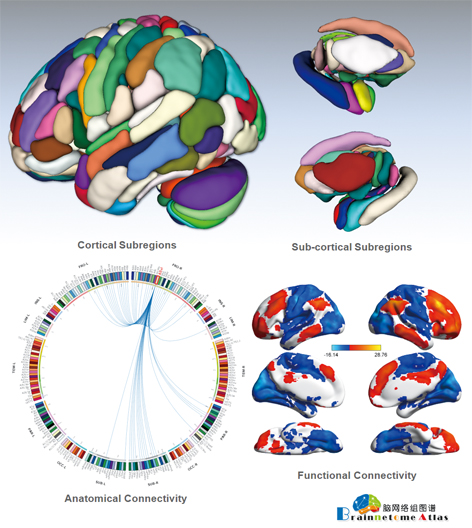In the past few years, scientists at the CAS Center for Excellence in Brain Science and Intelligent Technology have made a series of important original advances in the field of non-human primate models and human brain connection atlases.
Cloned Monkeys for Biomedical Study
Non-human primates are considered to be the best animal models, given that they are genetically the closest to humans. Cloning these animals, however, is a longstanding challenge; many attempts ended with no reward.
Things changed early 2018. Two live macaque monkeys, Zhongzhong and Huahua, were successfully cloned by a research team led by Profs. SUN Qiang and LIU Zhen at the CAS Institute of Neuroscience (ION)/CAS Center for Excellence in Brain Science and Intelligent Technology (Cell 2018, doi: 10.1016/j.cell.2018.01.020).

The two cloned monkeys Zhongzhong and Huahua. (Image by ION)
The team accomplished this feat via somatic cell nuclear transfer (SCNT), the same method that has made Dolly-the-sheep in the 1990s by replacing the nucleus of a chosen egg cell (the host) with the one extracted from a differentiated somatic cell (or body cell, the donor). Instead of using adult somatic cells with probable deficiency to be reprogrammed, they chose fetal nuclei as the DNA donor.
As a proof-of-the-concept demonstration, this lab technique could be used to produce many more identical cloned monkeys as ideal models for studying human biology and diseases, particularly when they carry a customized disease. This is truly an exciting milestone in biomedical studies. “In near future, China may grow into a global hub for biomedical studies and pharmaceutical tests for human diseases,” says ION director Prof. Muming Poo, who is a co-author of the study.
Transgenic Monkeys with Autism-like Behaviors
Though progress has been made using transgenic mice introduced with human autism-related mutations, scientists have been wondering whether complex mental illnesses such as autism can be accurately recapitulated by rodents. One thing is for sure that a human brain is far more complex than a rodent’s brain. Drug candidates that seem functional for rodents rarely work for humans. So, non-human primates are the ideal models for studying human brain disorders.

The world’s first non-human primate model to carry human autism gene and show autism-like behaviors. (Image credit: ION)
Rapid advances in genetic engineering enabled scientists to create non-human primate models that mimic many human neurologic diseases, such as Rett syndrome and Parkinson’s disease. In 2016, this same group as mentioned above established the first non-human primate model with transgenic cynomolgus monkeys that exhibit autism-like behaviors (Nature 2016, doi: 10.1038/nature16533), offering a new way to study brain disorders. These transgenic monkeys that recapitulate human neurologic diseases would not only provide a chance to grasp further understanding of how things go wrong in the brain, but also serve as a reliable platform for developing ways of medical interferences and testing drug candidates.
The Human brain Atlas
In 2016, scientists at the CAS Institute of Automation (CASIA)/ CAS Center for Excellence in Brain Science and Intelligent Technology illustrated a map known as “The Human Brainnetome Atlas” (Cereb Cortex 2016, doi: 10.1093/cercor/bhw157). This human brainnetome atlas could be used as an in vivo map, with more fine-grained functional brain subregions and detailed anatomical and functional connection patterns for each area, which could help researchers to describe more accurately the locations of the activation or connectivity in the brain. As a result, it would facilitate investigations of structure-function relationships, comparative neuroanatomical studies, and may promise new biomarkers for diagnosis and clinical studies.

The human brain atlases that reveal both anatomical and functional connectivity architecture in vivo. (Image credit: CASIA)

